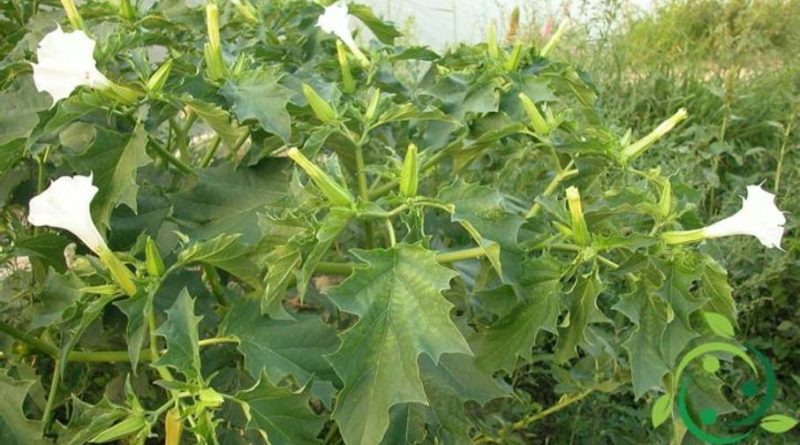Properties and uses of stramonium
Properties and uses of stramonium
The common stramonium (Datura stramonium L.), also known by the names of the devil’s grass and witches’ grass is an annual herbaceous species of the Solanaceae family. It is a highly poisonous plant due to the high concentration of some alkaloids, in particular the scopolamine, present in all parts of the plant and with a higher concentration in the seeds and with a seasonal and varietal variability. The seeds or flowers are used in the plant, sometimes used together with the leaves.
In this sheet we will see properties and uses of the Stramonium and the necessary warnings.
The common stramonium has a tap root, fusiform, with an erect stem, bifurcated branches and a height of two meters. The leaves are simple and alternate, large, petiolate, with oval lamina, asymmetric base and toothed-jagged margin. The plant has flowers of about 10 cm with white corolla, sometimes with purple hues, tubular, with 5 petals welded, sharp and pleated.
The common stramonium blooms between July and October and the flowers remain closed during the day and then completely open at night, giving off an intense and penetrating odor that attracts nocturnal butterflies; the pollination is in fact entomophilous and from this are formed the fruits that are globose capsules, divided into 4 lodges, the size of a thorny nut; inside there are many black and reniform seeds, about 3 mm long.
The grass names of the devil and witches’ grass refer to its narcotic, sedative and hallucinogenic properties, used both for therapeutic purposes and in magical-spiritual rituals by the shamans of many Indian tribes.
These properties are due to the presence of hallucinogenic alkaloids, including scopolamine and atropine.
The use of Datura stramonium for hallucinogenic purposes is extremely dangerous because the active dose of hallucinogenic alkaloids is very close to the toxic dose.
As mentioned, the alkaloid concentrations vary considerably from plant to plant and in different seasonal conditions (leaf 0.1 – 0.65%, seed 0.4 – 0.6%). This variability makes the production of dyes in concentrations standardized for therapeutic purposes complex.
The seeds of the common stramonium are composed of:
– tropanalcaloids: mainly giusciamina and scopolamine;
– beta-carbolinalcaloids such as fluorodetatin;
– 4-methyl-alcohols, lecithins, fatty oils and proteins.
Once the leaves were used for this plant, to relieve bronchial asthma, in the form of cigarettes containing also other medicinal herbs; until the obvious side effects and dependence that patients inevitably suffered by smoking such cigarettes every day were evident.
Unfortunately, a practice of remote times was also that of suicide using the plant. the death was due to the paralysis of the respiratory muscles.
Today, in modern phytotherapy, the common stramonium is still used for two applications:
– in paralysis agitans and other forms of tremor such as Parkinson’s syndrome, senor tremor, other hyperkinesis;
– against bronchial asthma in the form of fumigations and tinctures.

